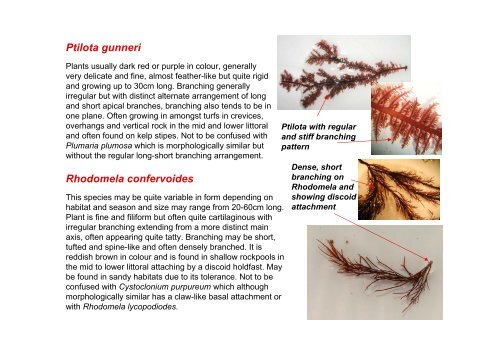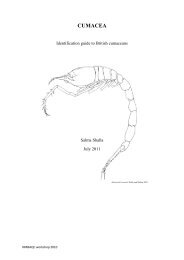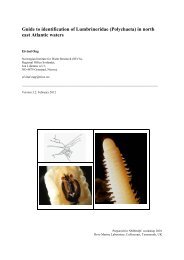s A Field Guide to the British Seaweeds - NMBAQC
s A Field Guide to the British Seaweeds - NMBAQC
s A Field Guide to the British Seaweeds - NMBAQC
You also want an ePaper? Increase the reach of your titles
YUMPU automatically turns print PDFs into web optimized ePapers that Google loves.
Ptilota gunneri<br />
Plants usually dark red or purple in colour, generally<br />
very delicate and fine, almost fea<strong>the</strong>r-like but quite rigid<br />
and growing up <strong>to</strong> 30cm long. Branching generally<br />
irregular but with distinct alternate arrangement of long<br />
and short apical branches, branching also tends <strong>to</strong> be in<br />
one plane. Often growing in amongst turfs in crevices,<br />
overhangs and vertical rock in <strong>the</strong> mid and lower lit<strong>to</strong>ral<br />
and often found on kelp stipes. Not <strong>to</strong> be confused with<br />
Plumaria plumosa which is morphologically similar but<br />
without <strong>the</strong> regular long-short branching arrangement.<br />
Rhodomela confervoides<br />
This species may be quite variable in form depending on<br />
habitat and season and size may range from 20-60cm long.<br />
Plant is fine and filiform but often quite cartilaginous with<br />
irregular branching extending from a more distinct main<br />
axis, often appearing quite tatty. Branching may be short,<br />
tufted and spine-like and often densely branched. It is<br />
reddish brown in colour and is found in shallow rockpools in<br />
<strong>the</strong> mid <strong>to</strong> lower lit<strong>to</strong>ral attaching by a discoid holdfast. May<br />
be found in sandy habitats due <strong>to</strong> its <strong>to</strong>lerance. Not <strong>to</strong> be<br />
confused with Cys<strong>to</strong>clonium purpureum which although<br />
morphologically similar has a claw-like basal attachment or<br />
with Rhodomela lycopodiodes.<br />
Ptilota with regular<br />
and stiff branching<br />
pattern<br />
Dense, short<br />
branching on<br />
Rhodomela and<br />
showing discoid<br />
attachment




